13/
HBO
Voyeur
BBDO New York
HBO Voyeur began with an event held in New York, before becoming a global phenomenon via a dynamic and interactive website. The aim of the campaign was to articulate the U.S. television channel’s skill for creating great stories. As storytelling in the modern age happens across all media, from television to the internet to conversations in the street, both HBO and its agency, BBDO New York, knew that a simple TV ad stating this wouldn’t be enough. Instead, they created a complex and absorbing narrative that played out across a multitude of media, and invited HBO’s audience to join in.
‘The first brief was to say that HBO were the pre-eminent storytellers,’ explains Greg Hahn, executive creative director on the project alongside Mike Smith. ‘The big shift we did on that brief was rather than to tell it, we decided to show it. That changed the way we looked at it. Rather than just going out and doing ads that said “HBO do great stuff”, we went out and created great content that was HBO-quality.’
The creatives came up with the theme of ‘voyeur’ based on their own experiences of living in New York City. ‘If you look across the street in New York there are 10,000 stories going on all the time,’ continues Hahn. ‘That is our story device, but we made it HBO-quality stories that are going on. It’s a simple thread that connects everything together, this idea of voyeurism.’
‘All of us moved to New York at exactly the same time,’ continues Smith. ‘We came from LA, from Minnesota… other places where we weren’t in such close proximity to other people. I remember staring out my bedroom window in New York and watching all these people live their separate lives. I think all of us had that same sort of epiphany that these stories are all around us.’
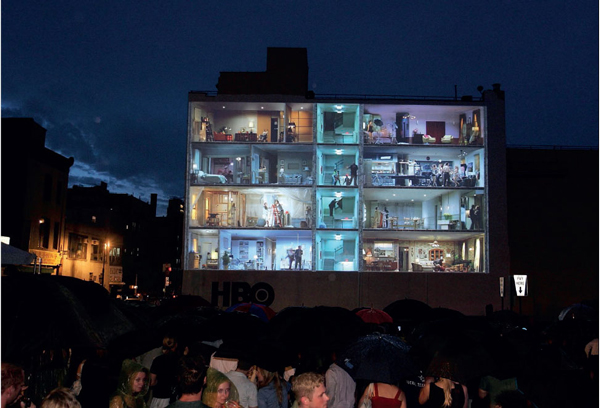
01 At the centre of the HBO Voyeur campaign is a film featuring a four-storey apartment block with the fourth wall removed, allowing the public to peer inside. The four-minute-long film, which reveals the various dramas that happen to the characters in the block over the course of an evening, was projected life-size onto a wall in downtown New York.
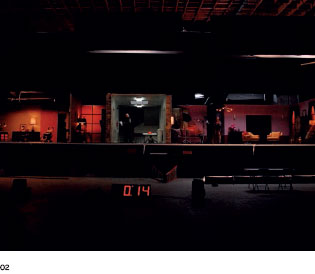
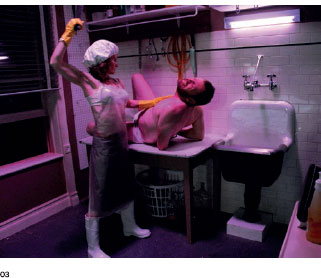
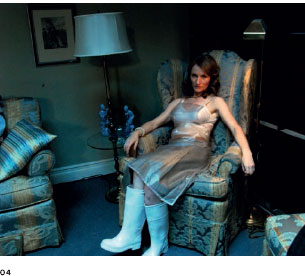
02-04 Production photographs taken during the shoot for the HBO film.
‘Rather than just going out and doing ads that said “HBO do great stuff”, we went out and created great content that was HBO-quality.’
From this, the creatives came up with the idea to create a four-minute film that allowed viewers to see into a set of apartments within a building and observe the narratives that connect all those dwelling inside. It was decided that the film should initially be projected onto a wall in the city, so that the apartments and people were shown life-size. Such an idea would also link the campaign in people’s minds to the classic movies Rear Window and Cinema Paradiso. ‘We had the notion of voyeurism and storytelling, and we felt the smartest way to [express this] was to project a cross-section onto the side of a building and show compelling stories there,’ says Smith. ‘We’d never really seen it done before and knew it was going to be tricky to pull off.’
The first obstacle was finding a space. The team began by looking at media spaces, but found none were suitable, so they handed the job to a location scout instead. ‘We were trying to find a place where people could really enjoy it, and stand or sit in front of the building,’ explains Brian DiLorenzo, director of integrated production at BBDO. The perfect building was found in the Lower East Side, in an area that, appropriately enough, DiLorenzo describes as ‘the Rear Window neighbourhood’. As it wasn’t within an area where advertising typically appeared, however, the team had to approach six different city departments to get permission to show advertising in the space.
Then there was the issue of whether the projection would be strong enough for the whole campaign to work. ‘We took two feature-film-quality cinema projectors – there were some that existed for outdoor projection – and we doubled them up because we wanted to be a lot brighter than the surrounding light pollution that comes from cities,’ says DiLorenzo. ‘It was a matter of making sure that we could line up all the pixels in a way that didn’t detract in terms of resolution and gave a “pop”. The pop is what really helped at the event – it made it seem as if there were a dimension to the building, that it was inside the walls instead of just being projected on the wall.’
BBDO commissioned director Jake Scott to create the film. ‘He’s a great visual storyteller,’ says Smith of the decision, ‘and he’s incredibly collaborative.’ The creatives worked with Scott to devise the various stories that would play out across the building, which contained eight apartments that were all joined by a central stairwell. The key was to create narratives that could be easily understood without sound, so the writers used big physical gestures and created archetypal scenes of comedy and tragedy. ‘At the bottom left you had a husband and wife who were arguing, and you realize that the argument is about him leaving because he’s having an affair with the woman in the top part of the building,’ says Smith. ‘Across the hall you have a woman who has a heart attack and dies. On the upper left, you had a couple who were about to give birth. You have a serial killer in one, and you have a couple who are renovating their apartment.’
The film had to be choreographed almost like a dance, and incorporated certain gestures or ‘beats’ that could be used as cues for the actors. ‘There are four of those within each story,’ says DiLorenzo, ‘if you watch for them you can see them. It’s organic, but there are gestures where all of a sudden in each apartment, everyone for a different reason is pointing. Stuff like that was all done to allow the actors to have performances but know that they had some sort of beat so they could work out the timing.’
This timing was vital as Scott shot the film floor by floor, building it up like a layer cake. Two cameras shot the action simultaneously, one filming the left apartment and stairwell, the other the right apartment and stairwell, and then the two films were synched. For the finished film, all four floors were joined together and the ceilings were painted and added in digitally.
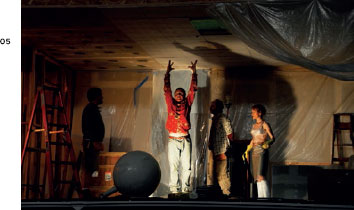

05-06 Director Jake Scott gives instructions to the actors on the set for the HBO film.
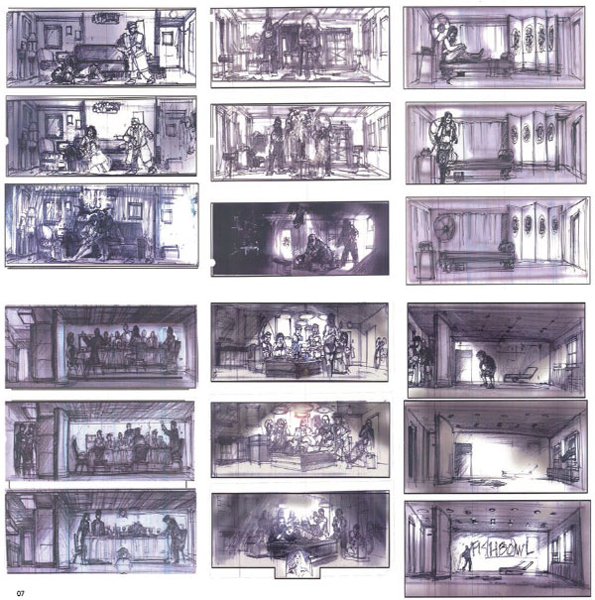
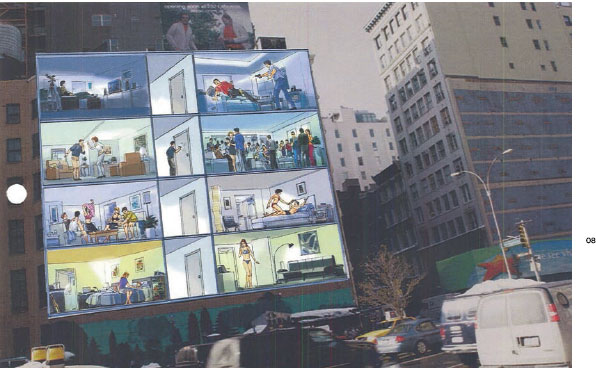
07-08 Sketches and storyboards by the advertising agency show how the ideas for the film were developed.
‘The thing that was probably most surprising to me was that we put all this content out and we kept writing and making more stories and taking stuff deeper and deeper.… There was a point between all of us when we thought, “is anybody really going to go this deep?”’
While the film was being created, BBDO was working with digital agency Big Spaceship to design the website for the ad campaign, which would carry on the narrative begun in the projection online. Big Spaceship brought the original film into the site, but added the chance for viewers to zoom in and interact with it. They then extended the city, so that users could explore a vast cityscape, where new stories could be discovered. As well as interacting with the site’s navigation, users were also offered the chance to choose a soundtrack for the experience online. ‘We gave six composers the opportunity to do a soundtrack. They ranged from Clint Mansell, who did the music for Requiem for a Dream, to people from the pop music industry, to traditional feature film composers,’ says DiLorenzo. ‘Big Spaceship made it so you could literally switch on the fly and hear one of these different compositions.’
The site went live at the same time the projection launched in 2007. The agency gave out invitations to the first screening to help build excitement around it, but once it aired it quickly attracted the attention of the wider media. The projection was a huge success, playing for two long weekends and attracting repeat viewers. ‘We could have been shut down for many reasons but they didn’t get one complaint from any of the neighbours,’ says DiLorenzo. ‘We would go back every couple of nights just to check on it ourselves and you’d see people who’d packed sandwiches to bring down to watch it.

09 A dramatic moment during the filming of the HBO Voyeur film.
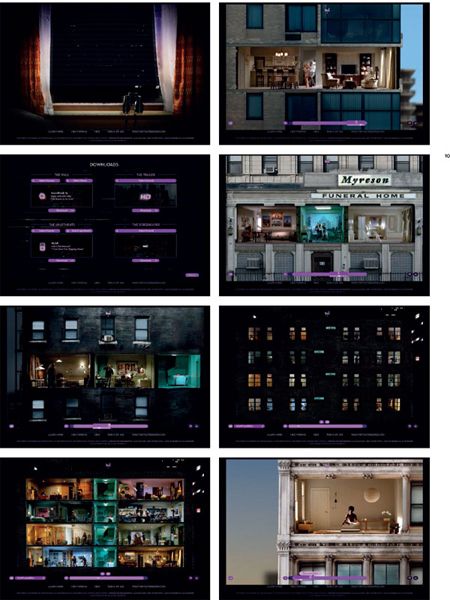
10 At the same time the film aired on the streets of New York, a website was launched, inviting those outside the city the chance to enter into the campaign. The site, designed by digital agency Big Spaceship, showed the film but also gave viewers the chance to engage further with the narrative.
‘It was gratifying seeing people talk to each other and figure it out as a group,’ he continues. ‘It was meant to have this communal thing, and it’s too much to see in one sitting. That was another reason we wanted to have the different music as well. We were able to play the soundtracks so every time it would loop there would be one of the other composer’s tracks going against it. You’d hear different music and it would highlight different emotions, so you’d pick up things you didn’t see in the first round.’ See what people do when they think no one is watching.
A promo for the project also aired on TV and in cinemas to draw viewers from outside New York to the website. Once there, viewers interacted with the content more quickly than even BBDO expected. ‘The thing that was probably most surprising to me was that we put all this content out and we kept writing and making more stories and taking stuff deeper and deeper,’ says Smith. ‘There was a point between all of us when we thought, “is anybody really going to go this deep?”’
They quickly discovered that people would. Among the new offerings was another film, The Watcher, which viewers could download from HBO On Demand. Clips could also be downloaded to iPods and PSPs, and tips and clues to the stories were sent out to mobile phones. A new character, a fictional blogger, then extended the story via his site, The Story Gets Deeper, which added new twists and turns to the plot. In the end, the team felt forced to announce an end point to the project, and they awarded those who followed it until its final moments with a document announcing that it was over.
While only a small group of dedicated fans completed all of its elements, HBO Voyeur was designed so that it would be comprehensible with only a small amount of contact, and enriching with more. In the end, millions of voyeurs joined in with the different aspects of the campaign, proving that if audiences are offered ad content that is intelligent and absorbing enough, they will eagerly become involved.
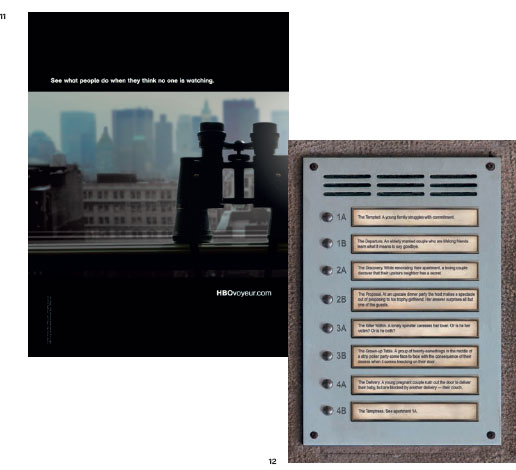
11-12 This programme was given out at the HBO Voyeur live event in New York. It gave brief information about the people living in the different apartments featured in the film, but also led viewers onto the website, where they could discover more treats connected to the campaign.
‘We wanted to have the different music as well. We were able to play the soundtracks so every time it would loop again there would be one of the other composer’s tracks going against it. You’d hear different music and it would highlight different emotions, so you’d pick up things you didn’t see in the first round.’
